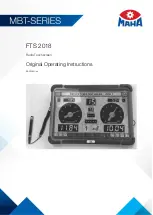
15
6.
INSPECTION, MAINTENANCE
AND REPAIRS
Unsafe operation
Insufficient or improper inspection and
maintenance, or inspection and maintenance
carried out by incompetent or unqualified
personnel, may result in unsafe operation,
defects and accelerated corrosion.
Ø
Inspection, maintenance and repairs of the
box cooler shall only be carried out by
suitably trained, qualified and instructed
engineers and electricians.
Ø
Draw up a schedule for regular inspection,
maintenance and cleaning.
Ø
Immediately repair or correct each
malfunction, defect or fault that may
generate a hazard.
Safe and sustainable operation and good performance can
only be retained if regular inspection and maintenance is
carried out.
Inspection and maintenance/repair consists of:
1.
Regular inspections during operation
2.
Internal inspection of the tube bundle and plugging of
tubes when a tube is leaking
3.
External inspection and cleaning of the tube bundle
and the sea chest every dry-‐docking period
4.
Cleaning / replacing the ICAF anodes, every dry-‐
docking period (if applicable)
6.1.
INSPECTION DURING OPERATION
The box cooler and the attached piping can be hot to
touch. Check the surface temperature carefully before
touching the box cooler or the piping.
During operation, regularly
6
inspect the following items:
q
Check that the
pressure
does not exceed the design
pressure (see section 2.4).
q
Check that the
liquid temperatures
meet the expected
values and are within the permissible design limits. If
the outlet temperature of the liquid is increasing
throughout longer periods of time, this may be an
indication that the box cooler has become fouled
(internally or externally). In that case further
inspection and cleaning may be necessary. See
section 6.2 and 6.3.
q
Check the
flow speed
. A too high flow speed (> 2.0
m/s) may cause erosion corrosion.
q
Check if there is still
air trapped
in the system.
Carefully and slowly open the vent and bleed the
system until no more air escapes. Proper system
bleeding is required to ensure optimal heat transfer
and to prevent water hammer.
q
Check for any
leaks
or signs of leakage. Apart from
direct observation, other signs for leakage are loss of
pressure, loss of cooling water and/or air keeps
coming into the system.
Note that the leakage can also be to the outside of the
ship, as the pressure in the system is higher than the
seawater pressure.
Examine the cause (see section 7) and repair leaks
when possible or contact Duramax Marine®.
q
Check the tightness of all
bolted connections
. Verify
alsothat no bolts or nuts are missing or broken.
Replace or retighten when needed (see section 4.4.4).
q
Inspect all surfaces for signs of
corrosion
and check
the condition of
coatings
. Pay special attention to the
top plate and the mounting frame, as these may be
attacked by galvanic corrosion.
6
The intervals between the following inspection and
maintenance activities are dependant upon the operating
conditions.
After maintenance or repairs it may be necessary to increase the
frequency of the inspections temporarily.







































